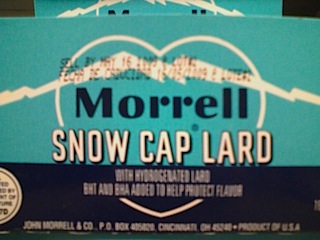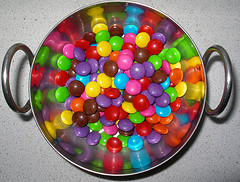Ten health experiments that you’re probably participating in
Aug 24, 2008 01:45 · 2549 words · 12 minute read
Science is great. According the Wikipedia entry on the scientific method:
Scientific method refers to the body of techniques for investigating phenomena, acquiring new knowledge, or correcting and integrating previous knowledge. It is based on gathering observable, empirical and measurable evidence subject to specific principles of reasoning. A scientific method consists of the collection of data through observation and experimentation, and the formulation and testing of hypotheses.
Research and new developments have come up with many, many ways to improve our lives. If you look at the stuff we buy at grocery stores and get from restaurants today, you’ll find that it’s quite different from what people would get 100 years ago. Hooray for progress!
The United States, being part of the developed world, clearly wouldn’t allow products to be on the shelf if they were unsafe, so we buy these food products with confidence. However, I’d like to point out one sticky little word in the first sentence defining the scientific method above: correcting. The scientific method assumes that we’ll continue learning about things over time and some of that learning will contradict and correct ideas that looked right in the past. The sun certainly appears to circle around the Earth, doesn’t it?
Remember how I mentioned that all of those food products are quite different than what people used to eat? Well, there’s the rub. As the products were put up for sale, they all seemed safe. But, in reality, we’re just participating in a vast experiment on the long term effects of all kinds of new creations.
Without further ado, here are 10 food and health related experiments that you’re likely participating in (and, contrary to the case of experimental drugs, you get to pay to participate, rather than being paid!)
1. Hydrogenated oils/Trans fats
When I was growing up, we  didn’t usually have butter in the house. We had margarine. Back then, margarine was made largely out of hydrogenated oils. People at the time thought that butter was bad, and margarine was likely cheaper to produce anyhow, so everyone was happy. That was until they found out that this fancy new stuff actually increases the risk of coronary heart disease.
didn’t usually have butter in the house. We had margarine. Back then, margarine was made largely out of hydrogenated oils. People at the time thought that butter was bad, and margarine was likely cheaper to produce anyhow, so everyone was happy. That was until they found out that this fancy new stuff actually increases the risk of coronary heart disease.
Apparently, the first commercialized hydrogenated oils were in Crisco, introduced in 1911. I love this bit from Wikipedia: they were trying to make candles, but “electricity began to diminish the candle market, and since the product looked like lard, they began selling it as a food.” Isn’t that great? Hey! the market for our product is going away, so let’s just sell it as food!
The trans fat experiment is coming to an end. California has banned them in restaurants. People are waking up to the problem (some woke up much earlier). Be wary, though: food makers snuck an interesting bit into the labeling law in the US. Anything less than 0.5 g of trans fat can be labeled as “0 g” of trans fat. Over the course of the day, it’s entirely possible to have all of those “0g” items add up to a good couple of grams of trans fats. The US recommended allowance of trans fats is as little as possible.
To maintain the texture (and cheapness) of their products, many companies are still using hydrogenated oils. Just look at the ingredients, and skip those products. Do you really want to eat something that’s bad for you because the manufacturer wanted to make it a few cents cheaper?
(Useful tip: Whole Foods, expensive though it may be, does not sell products with hydrogenated oils. Frito Lay voluntarily stopped using hydrogenated oils well before the labeling law made it obvious just how much of this bad stuff we were ating.)
2. Microwave ovens
In America, at least, microwave ovens are cheap and ubiquitous. And why wouldn’t they be? Who could pass up a chance to heat their food  in a fraction of the time it used to take?
in a fraction of the time it used to take?
Well, keep in mind that microwave ovens have only been in widespread use for the past 25 years, and we’re microwaving a much wider variety of foods than we used to.
But it’s just heating food, right? What could possibly go wrong?
Well, for starters, microwaving starches produces acrylamide. People usually use acrylamide for things like wastewater treatment, papermaking and manufacturing permanent press fabrics. Yum. Turns out that it’s been implicated in causing cancer.
And that’s all because microwave ovens heat food in a way in which humans have never heated food before. Are there other hazards beyond the problem with starches? Who knows!
3. High fructose corn syrup
Food manufacturers absolutely love substances that extend the shelf life of their products and are cheaper than the “normal” ingredients (see hydrogenated oils above). High fructose corn syrup (HFCS) is another one of those, and it shows up all over the place.
Nothing has been proven about high fructose corn syrup being bad for you. They kinda sorta think it might make you fat, and increase your risk of diabetes and high cholesterol, but that hasn’t been proven. Do you want to be a part of the experiment that proves it?
Interesting tidbit: Sabor Latino restaurant here in Ann Arbor offers “Mexican Coke” in a bottle. It has sugar rather than HFCS, and people buy it because they prefer the taste.
4. Soy everywhere
Soybeans have been consumed by humans for a long, long time. While soy has been praised as a “complete protein” and has a number of health benefits, there are also a number of questions about health risks. For example, recent studies showed that men who consume soy have reduced sperm counts. Many things are good for you in moderation, and soy may be one of those. The trouble is that soy is everywhere. The soy business in the US grew 10x between 1992 and 2003. In 2002-2003, soybean oil was about half of the vegetable oil produced.
5. Plastic bottles
I would never have assumed that chemicals from plastic containers would “leach out” into the food. I’ve stored food in plastic containers, bought food in plastic containers, used plastic water bottles. It turns out that there may be a big health experiment going on around us with at least one chemical, bisphenol A (BPA). Thankfully, the US Food and Drug Administration has declared that BPA is safe. I’m glad that they are looking out for us and apparently have done all kinds of research to contradict the “dozens of studies by government scientists and university researches [that] had found that BPA usage was a health concern”. Those pesky researches report that “the chemical has been linked to breast, ovarian and prostate cancer even at low doses”, but luckily we’ve got the FDA to set them straight. Yep, I’m sure the FDA is using the best of data.
The US chemical industry and agencies that regulate the use of BPA, however, have deemed the chemical safe, largely due to two industry-funded studies that gave it the all-clear.
“Industry-funded?” Maybe I shouldn’t trust the FDA after all…
6. Artificial colors
 In the US, artificial colors have been approved for use since 1906. With more than 100 years of experience, they must be safe, right? Well, there were 7 original approved colors. Wikipedia lists 10 colors that have been delisted, and 7 that are currently approved. For those original 7, it was just a matter of time before problems were discovered with them. Could that be the case now?
In the US, artificial colors have been approved for use since 1906. With more than 100 years of experience, they must be safe, right? Well, there were 7 original approved colors. Wikipedia lists 10 colors that have been delisted, and 7 that are currently approved. For those original 7, it was just a matter of time before problems were discovered with them. Could that be the case now?
Recent studies that artificial colors might cause behavioral problems in children might give you pause. They certainly give me pause.
Does it bother you that they keep trying different colors on the Florida oranges? Oranges are a fruit… fruits are supposed to be healthy.
7. Artificial sweeteners
When looking at the labels on products in the grocery store, I’ve noticed that sucralose (Splenda®) is everywhere. It shows up in breakfast cereals (look at the ones touting lower sugar) and even frozen pizzas. According to cancer.gov:
However, results from subsequent carcinogenicity studies (studies that examine whether a substance can cause cancer) on these sweeteners and other approved sweeteners have not provided clear evidence of an association between artificial sweeteners and cancer in people.
Of course there’s no “clear evidence of an association”. If there was, it certainly wouldn’t be on the market. My point in all this is that I’d rather not be consuming the products while the association may start to develop. And, the association is not necessarily a cancer. People have been consuming regular sugar (sucrose) for a long, long time. It’s easy to extract sucrose directly from nature. But, sucralose has only been consumed for the past 10 years.
By the way, I’m not saying that anyone has been negligent here. That same cancer.gov article says that “[b][efore approving these sweeteners, the FDA reviewed more than 100 safety studies that were conducted on each sweetener”. My issue is that it’s hard to study food products and it may be a long time before problems arise. There are plenty of good, tasty foods to eat that people have been eating for generations.
8. Genetic engineering
If Wikipedia were to be believed, the business of genetically modified food is more controversial than any potential health impacts. In this article, I only care about health aspects or potential health issues.
Arguably, we’ve been practicing genetic engineering on crops for a long, long time in the form of selective breeding. However, there are changes that we can make via modern genetic engineering that could not be made just via selective breeding, and these changes can be made much more quickly.
Perhaps golden rice will help solve vitamin A deficiencies in the developing world. Here in the US, I think I’d prefer to just snack on some carrots.
9. Refined carbohydrates
People today seem to know that whole grains are better than refined carbohydrates. After all, walking down the cereal aisle in the grocery store, you’ll see that all of the General Mills cereals proudly trumpet that they contain Whole Grain. (They would have trademarked that if they could.) That was a move they made this decade. That article was quite positive on the change, but the last paragraph bothers me:
General Mills executives won’t discuss the technology behind the changes. But industry executives believe it is similar to one used by ConAgra in a flour it introduced last month, Ultragrain. The flour is made by a special milling process that uses the whole grains but pulverizes them into tiny, uniform sizes.
I’m sure on the whole the switch to whole grains is a good switch, but this doesn’t make Lucky Charms sound any more natural to me.
All of that aside, I don’t remember much talk of this at all when I was a kid. People were happily buying their Wonder bread. My family generally bought some other brand of white bread. Originally, white bread was seen as a luxury. Today, white bread seems more like a problem than a luxury.
10. Hormones, antibiotics, fertilizers and pesticides
Though these are really separate things, I’m lumping them together as “yield increasers”. On the one hand, increasing yields is a good thing, because it means that there will be more food to go around and potentially fewer natural resources used in generating that food. Bovine Growth Hormone is routinely given to cows to increase milk production. As noted in Wikipedia, its use is outlawed in Canada out of concern for the animals. Health Canada found no “biologically plausible” safety concerns for BGH in humans. Wikipedia notes that BGH injections increase IGF-1, which has been linked to other diseases. Monsanto claims that the amount of IGF-1 in milk is negligible compared to what the body produces, but Monsanto wants to sell more BGH, right?
It’s also worth noting that cows given BGH are later used as meat, despite the fact that there are acknowledged health risks to the cows. Do you want to eat the meat from an unhealthy animal?
Fertilizers have a very roundabout health risk in the form of the dead zones created in the oceans.
Pesticides used on foods pose a variety of health risks and it’s telling that “the epidemiological evidence suggests a significantly higher rate of cancer incidence among farmers and farm workers in the US and Europe than among non-farm workers in some areas (Cantor et al. 1992).” That article contains an interesting bit about natural toxins in foods as well.
There’s no general conclusion to draw for these yield increasers, other than the fact that many of the specific techniques and chemicals are still new enough that long term effects may not truly be known.
And many, many more
There’s new news all the time about these kinds of experiments that we’re participating in. The FDA just approved irradiating some fresh produce in hopes of eliminating the threat of salmonella and e.coli. As noted in the NY Times, critics question whether the final food is as nutritious and they also question whether irradiation will even be an effective measure against many food-borne illnesses.
Consider other cases like cell phones. Do cell phones cause cancer? Who knows? One scientist says that there’s enough data to warrant at least taking precautions and using a headset. Prior to the last 15 years. there has never been a time in history when people routinely held transmitters right next to their heads. Sure, they’re safe in theory… but we haven’t even reached long term yet!
The number of long term health experiments being run on the human population, particularly in the US, is quite impressive. So far, the results are not encouraging, as the US ranks 42nd in the world in life expectancy, despite being the wealthiest nation and spending the most on health care.
I want to reiterate my initial point, because I’m pretty sure that someone is going to claim that I’m ignorant and afraid of progress. I work with high-tech stuff all day long and think that technology has transformed our world in many wondrous ways. But the fact of the matter is that the interactions between the human body and the food we eat and the environment we live in is extremely complicated. In “In Defense of Food: An Eater’s Manifesto”, Michael Pollan does a good job of illustrating that not only are these interactions complicated, but they’re also really hard to study.
Here in the United States, our government is just fine with our citizens taking part in these experiments. Where the government agencies feel that there is a risk, they often require labeling so that consumers have an idea what they’re getting into. This is not an irrational approach. Based on the information available today, though that information often comes from industry-funded studies, these products are deemed safe. But I, for one, would prefer to leave the long term experimentation to others. I am posting this article in hopes of giving some food for thought to others, because we do have a choice in much of the food we consume and products we use.
I heard about another book, Poisoned Profits, on the radio the other day. It sounds a bit alarmist, but covers these topics as well. If you feel like reading something a bit less even in tone, go for it!

